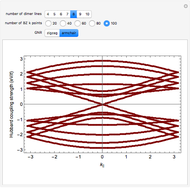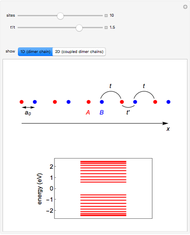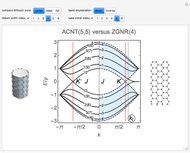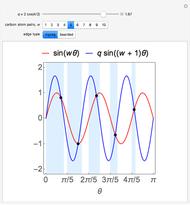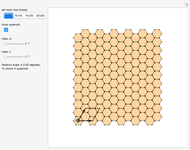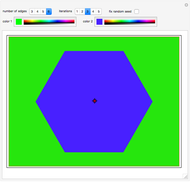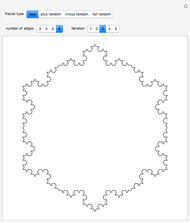Optical Selection Rules for Zigzag Graphene Nanoribbons

Requires a Wolfram Notebook System
Interact on desktop, mobile and cloud with the free Wolfram Player or other Wolfram Language products.
This Demonstration presents a complex analysis of the wavefunction parity and optical selection rules for zigzag graphene nanoribbons (ZGNRs). Selection rules are illustrated for optical transition matrix elements of a linearly polarized light. The plane of polarization of the incident light is parallel to the ribbon's longitudinal axis.
Contributed by: Vasil Saroka (August 2017)
Open content licensed under CC BY-NC-SA
Snapshots
Details
This Demonstration is based on the work in [1], which is an analytical extension of the work in [2]. All the notations are adopted from there. In particular, the energy bands of the ribbon are labeled by  , where
, where  labels the band number and
labels the band number and  , the band type. Therefore,
, the band type. Therefore,  stands for the conduction band,
stands for the conduction band,  for the valence band.
for the valence band.
The normalized wavefunctions (blue) and
(blue) and  (red) are plotted in the upper-left as functions of the normalized transverse coordinate
(red) are plotted in the upper-left as functions of the normalized transverse coordinate  , where
, where  is the
is the  coordinate of the
coordinate of the  atom in the ribbon unit cell and
atom in the ribbon unit cell and  is the width of the ribbon. The
is the width of the ribbon. The  coordinates of the atoms from the A and B sublattices forming a hexagonal structure of a zigzag graphene nanoribbon (ZGNR) are
coordinates of the atoms from the A and B sublattices forming a hexagonal structure of a zigzag graphene nanoribbon (ZGNR) are  and
and  , where
, where  , with
, with  being the number of zigzag chains specifying the width of the ribbon. The number of zigzag chains is
being the number of zigzag chains specifying the width of the ribbon. The number of zigzag chains is  , with
, with  being the number of carbon atoms in the zigzag ribbon unit cell. Then, the ribbon width is
being the number of carbon atoms in the zigzag ribbon unit cell. Then, the ribbon width is  . Thus, the ribbon with a certain width can be labeled as
. Thus, the ribbon with a certain width can be labeled as  . The wavefunctions
. The wavefunctions  (blue) and
(blue) and  (red) are offset for clarity by
(red) are offset for clarity by  and
and  , respectively.
, respectively.
The energy bands of a chosen  presented in the upper-right band structure plot are normalized by the hopping integral
presented in the upper-right band structure plot are normalized by the hopping integral  . The red and blue points in the band structure plot represent the states with wavefunctions
. The red and blue points in the band structure plot represent the states with wavefunctions  and
and  , respectively.
, respectively.
The lower-left plot shows the  and
and  wavefunctions overlapping for chosen
wavefunctions overlapping for chosen  and
and  .
.
The optical matrix elements  for a chosen transition
for a chosen transition  are presented in the lower right plot as functions of the electron wave number
are presented in the lower right plot as functions of the electron wave number  . These matrix elements are velocity matrix elements normalized by the Fermi velocity of electrons in graphene,
. These matrix elements are velocity matrix elements normalized by the Fermi velocity of electrons in graphene,  , where
, where  is the graphene lattice constant,
is the graphene lattice constant,  is the hopping integral, and
is the hopping integral, and  is the reduced Planck's constant. The black point denotes the matrix element value for the transition depicted in the band structure plot.
is the reduced Planck's constant. The black point denotes the matrix element value for the transition depicted in the band structure plot.
The point  corresponding to the Dirac point in graphene is marked by the vertical line labeled as
corresponding to the Dirac point in graphene is marked by the vertical line labeled as  in the energy band and matrix element plots. Similar marking by the vertical line is used for the transition point
in the energy band and matrix element plots. Similar marking by the vertical line is used for the transition point  , where the bulk states meet the edge states in the subbands
, where the bulk states meet the edge states in the subbands  and
and  .
.
Snapshot 1: the wavefunction (red) of the bulk state in the subband  of
of 
Snapshot 2: the wavefunction (red) of  at the transition point
at the transition point  , where the bulk states meet the edge states in the subband
, where the bulk states meet the edge states in the subband 
Snapshot 3: the wavefunction (red) of the subband  edge states localized at the ribbon edges for
edge states localized at the ribbon edges for 
Snapshot 4: forbidden transition  between valence and conduction subbands of
between valence and conduction subbands of 
Snapshot 5: allowed transition  between valence and conduction subbands of
between valence and conduction subbands of 
Snapshot 6: forbidden transition  between conduction subbands of
between conduction subbands of 
Snapshot 7: allowed transition  between conduction subbands of
between conduction subbands of 
Snapshots 1–3 show the transformation of the electron wavefunction (red) as one moves from the bulk to the edge states within the  subband. Snapshots 4 and 5 demonstrate the odd selection rule
subband. Snapshots 4 and 5 demonstrate the odd selection rule  for allowed transitions between the conduction and valence subbands. Snapshots 6 and 7 demonstrate the even selection rule
for allowed transitions between the conduction and valence subbands. Snapshots 6 and 7 demonstrate the even selection rule  for allowed transitions between the conduction (valence) subbands only.
for allowed transitions between the conduction (valence) subbands only.
References
[1] V. A. Saroka, M. V. Shuba and M. E. Portnoi, "Optical Selection Rules of Zigzag Graphene Nanoribbons," Physical Review B, 95(15), 2017 155438. doi:10.1103/PhysRevB.95.155438.
[2] H. C. Chung, M. H. Lee, C. P. Chang and M. F. Lin, "Exploration of Edge-Dependent Optical Selection Rules for Graphene Nanoribbons," Optics Express, 19(23), 2011 pp. 23350–23363. doi:10.1364/OE.19.023350.
Permanent Citation






